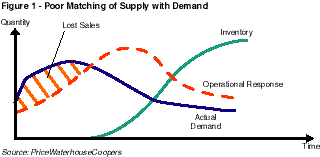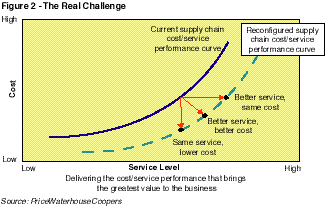|
Supply chain management is one of the industry buzzwords at the moment, but it can mean different things to different people
by Jim Kenny
Taking your place on the chain gang
The names may be unfamiliar to some people in the pulp and paper industry, but SAP, Intentia, Computer Associates, Numetrix, Ross, Baan, Oracle, Peoplesoft and i2 are just some of the companies that are setting out to make fundamental changes to way in which the paper industry does business.
Information technology has unleashed a massive dormant potential for adding value across the sector as businesses throughout the world embrace the internet and develop new work systems to make the most of the benefits that it can offer. And what benefits they are. Applying supply chain management solutions has already helped create one of the world's largest retail companies - Wal-Mart in the USA - and other industries are reaping not millions, but billions of dollars a year in cost savings from utilizing similar techniques.
The potential to add value has not been missed by pulp and paper groups though, and several of the world's leading players are already investigating the power of the technology - International Paper, Jefferson Smurfit, UPM-Kymmene and Metsä-Serla are just a few that have embraced the technology. Suzano in Brazil even announced that it was incorporating SAP's R/3 system into the organization in the company's annual report.
Rather than try to grapple with the mass of information that is available on the business benefits and an almost limitless number of software application configurations in a single feature, PPI is set to publish a number of articles on this topic over the next few months. In this issue, the idea is really to get a flavor of what the topic is all about try to gauge who is set to reap the advantages of the business systems on offer.
In the beginning
Getting a definitive definition on what supply chain management encompasses is not all that easy in fact. Elements of the topic stray into other areas such as manufacturing execution systems or enterprise resource planning and almost all the system vendors define the boundaries at slightly different points. As a result, there are vast areas of gray in terms of identifying which system defines which business role.
The most obvious analogy to the development of supply chain management systems would be paper machine automation. Going back to the evolution of the earliest CD profile sensors, paper mills decided that they needed a feedback loop to tell the process controllers further up the line to change according to specified specification limits. As the array of sensors spread to other elements of the papermaking process, so more units were integrated through programmable logic controllers and DCS systems. Pulp plant controls were eventually incorporated into the system until a mill-wide process control became a possibility and so on.
Supply chain management systems could be said to represent another step on the obvious route to a total business automation system. But the systems are not quite there as yet. Each company will have to make its own way along the path, but the software applications already exist for almost every conceivable business operation. It's "simply" a matter of choosing which elements of the package fit your company's needs.
Tricky topic
In fact, this is possibly the trickiest part. Companies are faced with a daunting task when opting for a new system . For example, you could go for integrated applications, which will have fewer interfaces to maintain and offer single supplier responsibility, but it might also have gaps in its functionality. Alternatively, the buyer could go for a range of "best of breed" or "best in class" applications, which will be quicker to get online and can be tailored to get a better functional fit. But such systems may not always integrate in the way the company wishes and combining the systems could mean that any operational gains are lost in maintaining the system.
What is clear is that the clever buyer will have carried out an exhaustive study of what it is - exactly - that the company needs before even opening page one of the vast number of glossy manuals on offer. The good news though, is that most of the major software systems on the market can be purchased in discrete packages. Each element may cover asset management, sales and distribution or production planning, for example, rather than relying on the customer to take a leap of faith by trying to install an all-encompassing software solution in a single step.
SAP in Germany for example, has a software suite that covers eight main business operations. Included within the enterprise management level, for example, are strategic enterprise management, management accounting, financial accounting and data support. According to SAP, most new users start off with the financial elements before integrating other elements of the system into their business.
Get together
When it comes to implementation, some companies are much further advanced than others. In Sweden for example, Duni recently announced that it had teamed up with the supply chain management consultancy, Roce Partners, to implement i2 Technologies' Rhythm software as its preferred supply chain solution.
Duni is confident that the Rhythm software system will allow the group to "reduce inventories, enhance supply efficiency via multi-site optimization, improve product phase-in and phase-out planning and ensure high customer satisfaction".
According to Jonas Ahlberg, partner at Roce, "The i2 solution will provide Duni with global supply chain visibility, enabling it to react much faster to changes in demand and supply. This solution will allow Duni to increase its return on capital employed by reducing inventories, while simultaneously allowing it to maintain high customer service levels."
Depending on the business in question, i2 Technologies estimates that the benefits of supply chain management can be as much as:
- a 95% reduction on planning cycles
- a 2-5% increase in throughput
- a 10-25% reduction in inventories
- a 10-50% drop in operating expenses
- and a drop in late orders by between 25-50%.
The idea is certainly logical. If your company fails to match supply and demand, that has serious financial implications for your business (Figure 1). But life need not be like that, as the principal consultant for global forest and paper practices at PriceWaterhouseCoopers, Scott McLean, points out. If your company can integrate all the activities, resources and information it needs to plan, source, manufacture, store, sell and deliver products to customers, there are going to be a mass of benefits in terms of both financial performance and customer satisfaction. That process involves analyzing, assessing and delivering the cost/service performance that will bring the greatest value to the business (Figure 2).


Too many
At present, there are a vast number of new applications and enhancements being introduced to supply chain management systems. Certainly, there are too many innovations coming through to cover here, but we have taken just a couple of examples to highlight how the process is developing (see boxes).
Over the next few issues of PPI though, we will attempt to flesh out some of the introduction here and develop a more rounded picture of how supply chain management is going to impact the pulp and paper industry.
Going via the web
Numetrix was one of the pioneers of supply chain management (SCM) solutions, but the group has most recently concentrated its efforts on a new software product designed to optimize the total supply/demand network for extended enterprises and entire industry sectors via the internet.
Using the internet as a channel for low-cost information exchange, the company's xtr@ system delivers real-time business processes such as sales and operations planning (S&OP); vendor managed inventory (VMI/ECR); available to promise (ATP) and capable to promise (CTP). Each of these processes allows for optimized, enterprise-wide collaboration among suppliers, manufacturers, distributors and customers.
In other words, the system delivers up-to-the-second information than enables companies to accurately manage and interpret the flow of data that passes across their supply/demand networks.
Herlitz is one of Europe's major paper industry players that has embraced the technology. As the company's director of services/operations in central Europe, Michael Müller, points out, "[The xtr@ system] will enable us to improve services to our business customers through web-supported order planning and will help us to achieve greater flexibility in our inventory management, allowing us to forecast follow up orders in a faster and more precise manner."
|
Supply Chain Management
Intentia International is just one of the major suppliers that is in the process of tailoring its supply chain management solution to the paper industry's specific needs. According to Ted McDermott, Intentia director for the paper and converting sectors, "In such a price-driven, tight margin industry, maintaining competitiveness depends on good planning, cost control and production management."
In response, the company has developed Movex Paper - a system specifically designed to support manufacturers, converters and suppliers throughout the supply chain. Movex is a totally integrated manufacturing, distribution, financial solution that is designed to run on the IBM AS/400 hardware platform.
But Intentia is not alone in this market segment. Among the many other companies battling it out for market share is Germany's SAP group, which has been working closely with a number of big-name papermakers.
Aspen Technology has also identified the market as a potential winner and it has expanded the logistics management capability of its MiMi-based supply chain management solution in an attempt to capture a share of the rapidly growing market.
|
|